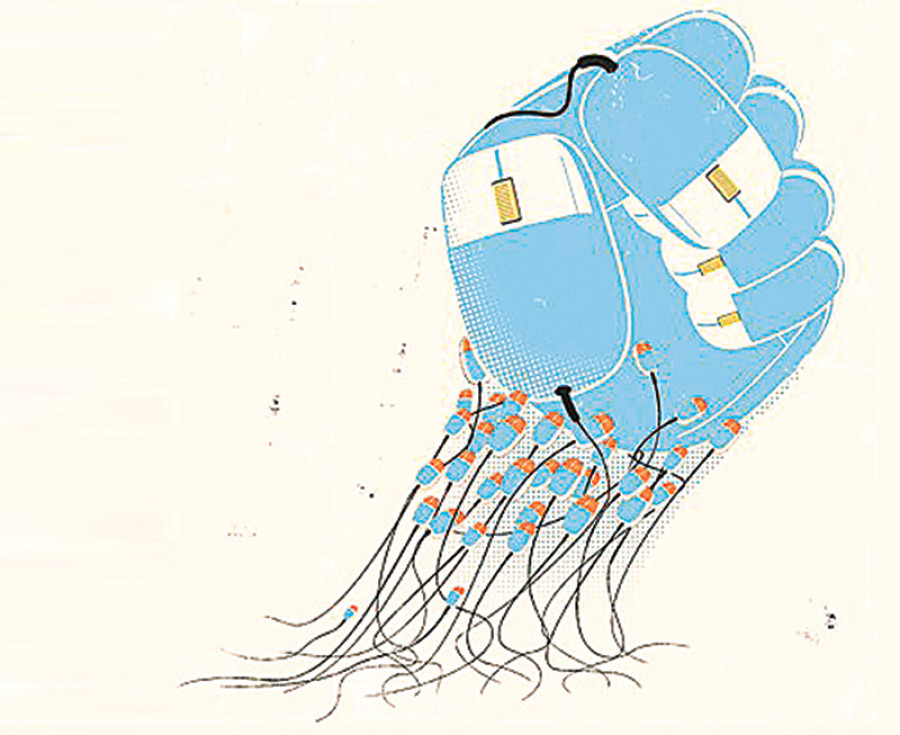Miscellaneous
Age of the armchair activist
I vividly remember the fervor that had gripped my hometown in Jhapa during the Jana Andolan of 2006. People descended onto the streets by the thousands, determined to overthrow the monarchy in order to reinstate a federal republic.
Sailendra Adhikari
I vividly remember the fervor that had gripped my hometown in Jhapa during the Jana Andolan of 2006. People descended onto the streets by the thousands, determined to overthrow the monarchy in order to reinstate a federal republic. What’s more, all this was achieved through door-to-door campaigns, mass publicity through loudspeakers mounted on the back of vehicles, and through pamphlets urging others to join the protests. Back then, connecting with people was monotonous and tedious; but still the message reached the masses, and the masses responded through a massive show of force.
Fast forward a decade, and the emergence of social media has simplified this chore of connecting with one another. Now, you don’t have to carry a flag or march in rallies to show that you care or are aware of an issue. Just like a photo, or retweet a tweet, or post content with a catchy hashtag and there it is. Your support for the cause has been noticed. Why go and scorch in the hot sun and listen to speeches by leaders in programmes that start hours behind schedule, when you can just pick up your phone and do it with the tip of your fingers?
Social media has undoubtedly converted the world into a large village. Today, the dissemination of information is easier than ever before and communication is getting easier by the day. The true benefits of social networking’s prowess, some argue, was truly realised during the 2015 earthquakes. At the time, people used social platforms, namely Twitter and Facebook, to communicate, stay informed and inquire about or locate their loved ones in the aftermath of the disaster. With land lines or mobile lines either down or stretched to their limits and roadways blocked or unreachable, the use of social media at times of such great calamity became integral in shaping our post-disaster response.
With the disaster now behind us and its sobering lessons sadly forgotten, Nepalis are turning to social media for greater causes. Gone are the days when you simply posted photos or a status to strengthen your social circle. There are greater issues to deal with while using these tools.
Of late, Nepal has seen sharp rise in use of social media for political activism and protests. Be it supporting the case of a fasting doctor with #IamWithDrKC or asking a neighbouring country to respect one’s sovereignty with #BackOffIndia, people are taking to social media to organise and express political or social dissent. Using a common hashtag allows protestors to enjoy a unity even before taking to streets. Social media has not only shaped the ways protests are organised but with its emergence movements are no longer monopolised by one single person or a party. It has become markedly easier to air out your views to the world and to connect with other with similar worldviews. For instance, with the #BackOffIndia hashtag that went viral, there were no defined political forces leading the charge. The initiative was seized by vocal Tweetaratis, bouncing off of each other’s tweets and memes.
While few can debate the effectiveness of social media during protests around the world—the Arab Spring being a case in point—doubts remain about its capacity to affect change in Nepal. Blogger Anil Ghimire, who extensively writes about social media, has estimated that there are currently up to 400,000 active Twitter users in Nepal, with the number for Facebook hovering around 7.2 million. But while social media does connect a large number of people to one another, in Nepal, that seldom translates into large participation during rallies and protests. This week, the impeachment motion set against Chief Justice Sushila Karki, created a social media firestorm. Gauging by the vocal and angry reaction from all quarters on Facebook and Twitter, you would have thought that the streets would be inundated with protests the next day. But were they really? Barring protests at Maitighar and one at Basantapur—both of which drew fewer protestors than say the #IAmWithDrKC movement—it was just another day in Kathmandu.
With the country heading for polls soon, social media has naturally been abuzz with political overtures. Whether candidates are banking on their youth, their experience or nothing really at all, it is not uncommon to see interviews and articles end up seeing thousands of likes and shares within hours. Even grand old parties seem to have caught to drift and are launching well-crafted, populist videos on the internet. But will these likes and retweets translate into real votes come election day?
This year will mark Nepal’s first local elections in two decades. It is also arguably the first since the explosion of social media into our lives and consciousness. But with chronic inactivity and fatalism plaguing everyone from the very top rungs of the government to the grassroots, will all this web-based hullaballoo really amount to anything at all? Will tech-savvy new entrants seize the day and use their mileage on the internet to cause major upsets in the urban clusters? Or are traditional political forces, their organisation, vast resources and muscle, too deeply entrenched to usurp? Is social media helping sow seeds of change? Or are we, after all, just a hallai halla ko desh?
We shall find out next week for sure, but I for one, wouldn’t be surprised if it is all much-to-do-about-nothing. Until then, move along back to your phones.




 19.12°C Kathmandu
19.12°C Kathmandu










